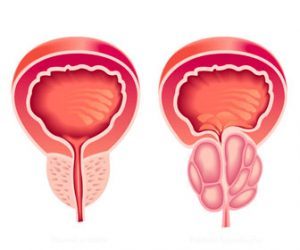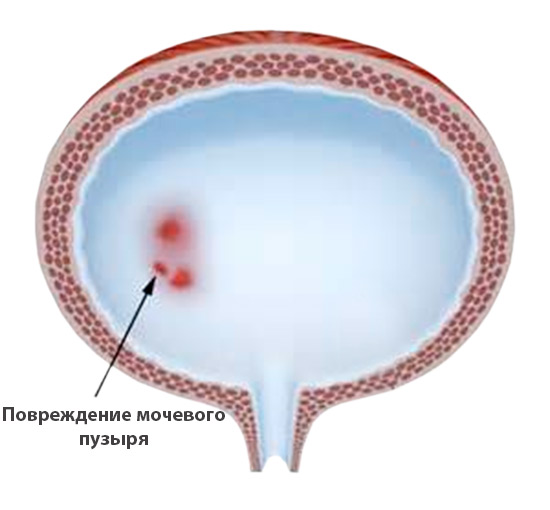Causes of bladder enlargement
The normal volume of the bladder reaches half a liter, and its size varies depending on the age category of a person, his height and weight. Based on the individual device of the body, the body can stretch and contain up to 1 liter of liquid. The size of the urinary cavity is determined using an ultrasound examination or thanks to special formulas.
Organ volume is normal
Sizes for women and men
The size of the bubble depends on the person's gender and age. Consider normal indicators:
- in women, the volume of the bladder varies from 250 to 500 milliliters;
- in men - from 350 to 700 milliliters.
Organ volume in newborns and older children
The bladder of a newborn baby is about 50 milliliters, increasing week by week. The size of the organ in older children also increases with age and is:
- in children under 1 year old - 35-50 ml;
- from 1 to 3 years - 50-70 ml;
- from 3 to 8 years - 100-200 ml;
- from 9 to 10 years old - 200-300 ml;
- from 11 to 13 years old - 300-400 ml.
Normal body wall thickness
 Ultrasound diagnostics will accurately determine all indicators of the organ.
Ultrasound diagnostics will accurately determine all indicators of the organ.
To understand whether the walls of the bladder have increased, it is important to know exactly what wall thickness should be normal. The indicator is determined using an ultrasound examination of the urinary system, and only the doctor can correctly interpret the results of the analysis. A healthy organ should have the following characteristics:
- round shape;
- clear and even contours;
- wall thickness ranging from 3 to 5 millimeters (it is important to note that their thickness may be slightly less when the bladder is full);
- the rate of urine outflow in 14 seconds;
- bladder filling - 50 milliliters per hour;
- residual urine within 50 milliliters.
What affects the size of the urinary cavity?
Bubble capacity sometimes changes throughout the life cycle. The change in the size of the body depends on such factors:
- operations on the small pelvis;
- pathologies in the structure of neighboring organs;
- the use of certain medications;
- benign and malignant neoplasms in the body;
- pathologies of a neurological nature;
- period of pregnancy;
- old age.
 Prostatitis in men can cause an increase in the size of the bladder.
Prostatitis in men can cause an increase in the size of the bladder. The size of the bladder, according to many studies, can change due to severe stress, this is observed in women and men. To restore the former capacity of the bladder, specialists help the patient get rid of nervous tension and restore the emotional background. Thanks to this, the patient can again exercise control over the process of urination.
Some of the above changes are reversible, and the diameter of the bladder returns to the size it was before. This applies to the period of pregnancy and the use of certain types of medicines. In cases of changes in the volume of the bladder due to other factors, it can return to its previous size only after the doctor has carried out the correct treatment or, in some cases, surgery.
How do changes in organ size manifest themselves?
Deviations in the thickness of the walls of the bladder and its size are not ignored, as they change the patient's life for the worse. Patients begin to experience the following symptoms:
- frequent urination (more than 5 times during the day and about 3 times at night);
- uncontrollable urge to urinate;
- decrease in the amount of excreted urine.
In cases where the bladder decreases, it is more likely to fill with urine, which is why the urge to urinate becomes more frequent. If the organ increases in size, and the amount of urine does not increase, failures in the process of urination also begin, which are characterized by constant urge to go to the toilet.
How to calculate the size of an organ?
In adults
To determine the capacity of the organ, specialists conduct an ultrasound of the bladder, which allows you to automatically find out its capacity. The obtained information is used to study the urinary cavity, check for the presence of diseases of the urinary system and study the volume of remaining urine. However, there is a way to determine the size of an organ without sending it to an ultrasound.
Formulas by which the capacity of the organ of an adult male and female is established:
- Bladder capacity (in milliliters) = 73 + 32 x N (N is the patient's age);
- EMP \u003d 10 x M (M is the patient's body weight);
- UMP \u003d 0.75 x A x L x H (A is the width, L is the length, and H is the height of the bladder, which can be found using organ catheterization).
In newborns and children
What should be the capacity of the body in a child? In a newborn, the bladder is determined only at the 12th week of pregnancy. The size of the organ in newborns will vary depending on the fullness of the cavity. In children under 10 years of age, the capacity of the bladder is determined according to the following formula: 600 + (100 x (N -1)), where N is the age of the child. For children over 10 years old, the formula changes: 1500 x (S: 1.73), where S is the surface of the body. Body surface parameters can be taken from the table below.
A table with a ready-made calculation of the body surface depending on the weight and height of a person:
| The weight | 40 kg | 45 kg | 50 kg | 55 kg | 60 kg | 70 kg | 80 kg | 90 kg | 100 kg | 120 kg |
| 110 cm | 1,04 | 1,09 | 1,14 | 1,19 | 1,24 | 1,32 | 1,40 | 1,47 | 1,54 | 1,66 |
| 120 cm | 1,11 | 1,17 | 1,22 | 1,27 | 1,32 | 1,41 | 1,49 | 1,56 | 1,64 | 1,77 |
| 130 cm | 1,17 | 1,23 | 1,29 | 1,34 | 1,40 | 1,49 | 1,58 | 1,66 | 1,73 | 1,87 |
| 140 cm | 1,24 | 1,30 | 1,36 | 1,42 | 1,47 | 1,57 | 1,66 | 1,75 | 1,83 | 1,98 |
| 150 cm | 1,30 | 1,37 | 1,43 | 1,49 | 1,55 | 1,65 | 1,75 | 1,84 | 1,92 | 2,08 |
| 160 cm | 1,37 | 1,44 | 1,50 | 1,56 | 1,62 | 1,73 | 1,83 | 1,93 | 2,02 | 2,18 |
| 170 cm | 1,43 | 1,50 | 1,57 | 1,63 | 1,69 | 1,81 | 1,92 | 2,01 | 2,11 | 2,28 |
| 180 cm | 1,49 | 1,56 | 1,63 | 1,70 | 1,77 | 1,89 | 2,00 | 2,10 | 2,20 | 2,37 |
| 190 cm | 1,55 | 1,63 | 1,70 | 1,77 | 1,84 | 1,96 | 2,08 | 2,18 | 2,28 | 2,47 |
| 200 cm | 1,61 | 1,69 | 1,76 | 1,84 | 1,91 | 2,04 | 2,15 | 2,27 | 2,37 | 2,5 |
Why does an organ shrink?
In both sexes, a small bladder can be due to such groups of reasons:
- Functional. They are observed due to malfunctions of the body.
- Organic. They are diagnosed in cases of pathologies of the structure of the wall of the urinary cavity.
 With interstitial cystitis, there is a functional decrease in the bladder.
With interstitial cystitis, there is a functional decrease in the bladder. Functional decrease is characterized by overactive bladder. This disease is caused by failures in supplying the organ with nerves or their poor functioning. During the illness, the patient experiences frequent urination. Organic causes arise in cases of the development of diseases, which are characterized by a long duration of inflammatory processes that adversely affect the walls of the bladder. In cases of such diseases, the tissues of the organ begin to be replaced by connective tissue, in the process of which its capacity decreases. It is important to know what diseases this happens due to:
- Interstitial cystitis, which is an inflammatory process in the urinary cavity of a non-bacterial nature. In case of illness, the patient feels frequent urination, pain in the peritoneum, often a small amount of blood in the urine.
- Tuberculosis of the organ, which is a bacterial disease, is provoked by tuberculosis bacilli.
- Cystitis radiation - inflammatory processes in the urinary cavity due to chemotherapy.
- Schistosomiasis, which is a disease that develops due to infection with a flatworm.
- Prolonged artificial withdrawal of urine, for example, after surgery.




